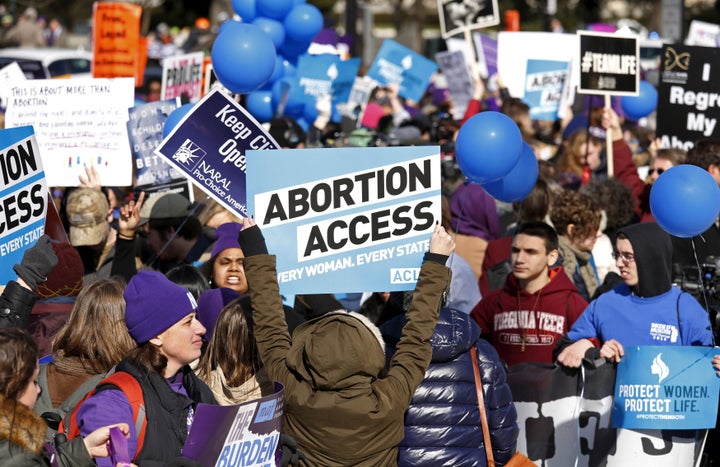
This past week marked the 44th anniversary of the Supreme Court’s decision in Roe v. Wade. I’m proud to say that I was there at the time. By “there,” I mean that I was a law clerk to Justice William J. Brennan, Jr. when Roe was decided. Because Brennan played a critical role in helping to craft the Court’s opinion, it was a truly fascinating experience.
Many Americans today think of Roe v. Wade as a radical, left-wing decision. That was not the view at the time. By 1973, a substantial majority of Americans supported the right of a woman to terminate an unwanted pregnancy. Gallup polls at the time showed that “two out of three Americans think abortion should be a matter for decision solely between a woman and her physician.”
Moreover, three of the four justices appointed to the Supreme Court by President Richard Nixon, who had dedicating himself to appointing “conservative” justices, joined the decision. Indeed, without their support, Roe would have come out the other way. That Warren Burger, Harry Blackmun and Lewis Powell joined Justices Douglas, Brennan, Stewart and Marshall in Roe speaks volumes about the mainstream nature of the decision.
The plain and simple fact is that, at the time Roe was decided, even Blackmun, Burger, and Powell did not view abortion as posing a particularly ideological question. Although all of the justices understood that Roe addressed a profoundly important question, none of them imagined that it would later become a flashpoint of American politics or that it would continue to shape those politics for decades to come.
This understanding of Roe is consistent with both the news coverage and the public reaction at the time. Because Lyndon Johnson died on the same day that the Court announced its decision in Roe, newspapers, magazines, and news shows treated the Court’s decision as only a secondary headline. The primary story was the death of the former president. U.S. News & World Report, to cite just one example, did not even mention Roe on the front page of that week’s issue. As the editors observed 40 years later, “the far-reaching effects of the decision weren’t evident at the time.”
This view is consistent with the overall tenor of the editorials and commentary about Roe in the days after the decision. In general, they tended to be approving. Even newspapers in Georgia and Texas, whose laws had been held unconstitutional in Roe, were supportive. The Atlanta Constitution characterized the decision as “realistic and appropriate,” the Houston Chronicle called it “sound,” the San Angelo Standard-Times applauded it as “wise and humane,” and the San Antonio Light gushed that although the ruling was “not perfect, . . . it was as close to it as humanly possible.” These responses were not at all surprising in light of the fact that the American people clearly endorsed the decision. In polls taken at the time, only forty-one of Americans disapproved of the decision.
To put that in perspective, it is instructive to compare the public’s reaction to Roe with its reaction to other, more controversial, decisions. In 1962, for example, after the Supreme Court held prayer in public schools unconstitutional, 79 percent of the American people disapproved of the decision. In 1967, after the Court held laws prohibiting interracial marriage unconstitutional, 72 percent disapproved. In 2010, after the Court held laws limiting corporate campaign expenditures unconstitutional, 80 percent of Americans disapproved. But only 41 percent of Americans disagreed with Roe. An additional measure of just how uncontroversial Roe was at the time is the fact that, when President Gerald Ford nominated John Paul Stevens to succeed Justice William O. Douglas in 1975, not a single senator asked Stevens a question about Roe or about his views on abortion.
How could this have been? What did Americans think about abortion in 1973? What they thought about abortion was largely informed by the experience of women and by what they knew about that experience. In the years leading up to Roe, approximately one million women each year had an illegal abortion. The vast majority of those women had to resort either to dangerous self-induced abortions or to the dark and often forbidding underworld of untrained and unreliable “back-alley” abortionists.
Women who resorted to self-induced abortion typically relied on such methods as throwing themselves down a flight of stairs or ingesting, douching with, or inserting into themselves a chilling variety of chemicals and toxins ranging from bleach to potassium permanganate to turpentine to gunpowder to whiskey. Knitting needles, crochet hooks, scissors, and coat hangers were among the tools commonly used by women who attempted to self-abort. Approximately 30 percent of all illegal abortions were self-induced.
Women who sought abortions from “back-alley” abortionists encountered similar horrors. To find someone to perform an illegal abortion, women often had to rely on the advice of friends or acquaintances or on tips from elevator operators, taxi cab drivers, salesmen, and the like. Because of the clandestine nature of illegal abortions, the very process of finding an abortionist was often dangerous and terrifying. Women who sought “back-alley” abortions were sometimes blindfolded, driven to remote areas, and passed off to people they did not know and could not even see during the entire process. Such abortions were performed not only in secret offices and hotel rooms, but also in bathrooms, in the backseats of cars, and literally in “back alleys.” The vast majority of these abortions were performed either by persons with only limited medical training, such as physiotherapists, midwives, and chiropractors, or by rank amateurs, including elevator operators, prostitutes, barbers, and unskilled laborers. In the 1960s, an average of more than 200 women died each year as a result of botched illegal abortions.
In addition to those who died in the course of illegal abortions, many thousands more suffered serious illness or permanent injury. The stories of women who suffered through this nightmare are legion. One woman recalled how a fellow college student who had had an illegal abortion was too frightened to tell anyone what she had done. She locked herself in the bathroom in her dorm and quietly bled to death. In another incident, 28-year-old Geraldine Santoro bled to death on the floor of a Connecticut hotel room after she and her former lover attempted an abortion on their own. The former lover, who had no medical experience, used a textbook and some borrowed tools. When things went terribly wrong, he fled the scene, and Santoro died alone.
This was the world pre-Roe v. Wade. Faced with the realities of this world, the justices of the Supreme Court attempted in Roe to settle the abortion issue then and there, once and for all. Of course, it turned out not to be that simple. A succession of Republican presidents have appointed justices to the Court in the hope and expectation that they would vote to overrule Roe. Thus far, they have been disappointed, as justices like John Paul Stevens (Ford), Sandra Day O’Connor (Reagan), Anthony Kennedy (Reagan), and David Souter (Bush I) have risen above partisan ideology to preserve the fundamental right of women to control their own lives and destinies ― the right recognized by the Supreme Court forty-forty years ago.
Indeed, over the years, and by a margin of nine to six, more Republican-appointed than Democratic-appointed justices have voted to preserve and to protect a woman’s right to choose. But now we once again face a crisis. There is little doubt that Chief Justice Roberts and Justices Thomas and Alito would vote to overrule Roe, if given the chance. If Donald Trump gets two appointments to the Supreme Court, there is every reason to believe that he will appoint justices who are certain to overrule Roe. And then, if that happens, we will once again see millions of American women forced to resort to dangerous, terrifying, and humiliating unlawful abortions in an effort to preserve their own dignity, their own autonomy, and their own lives. If we return to those dark and ugly days, it will truly be a tragedy for our nation.
